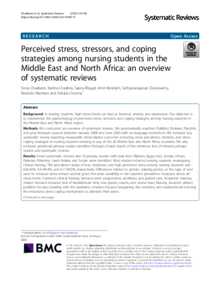وثيقة
Perceived stress, stressors, and coping strategies among nursing students in the Middle East and North Africa : an overview of systematic reviews.
المعرف
DOI: 10.1186/s13643-021-01691-9
المصدر
Systematic Reviews. v. 10, 1, 136
المساهمون
Chaabna, Karim., مؤلف
Bhagat, Sapna., مؤلف
Abraham, Amit., مؤلف
Mamtani, Ravinder., مؤلف
Cheema, Sohaila., مؤلف
الدولة
United Kingdom.
مكان النشر
London
الناشر
BioMed Central Ltd.
ميلادي
2021-12-01
اللغة
الأنجليزية
الموضوع
الملخص الإنجليزي
Background: In nursing students, high stress levels can lead to burnout, anxiety, and depression. Our objective is to characterize the epidemiology of perceived stress, stressors, and coping strategies among nursing students in the Middle East and North Africa region. Methods: We conducted an overview of systematic reviews. We systematically searched PubMed, Embase, PsycInfo, and grey literature sources between January 2008 and June 2020 with no language restrictions. We included any systematic review reporting measurable stress-related outcomes including stress prevalence, stressors, and stress coping strategies in nursing students residing in any of the 20 Middle East and North Africa countries. We also included additional primary studies identified through a hand search of the reference lists of relevant primary studies and systematic reviews. Results: Seven systematic reviews and 42 primary studies with data from Bahrain, Egypt, Iraq, Jordan, Oman, Pakistan, Palestine, Saudi Arabia, and Sudan were identified. Most studies included nursing students undergoing clinical training. The prevalence range of low, moderate, and high perceived stress among nursing students was 0.8–65%, 5.9–84.5%, and 6.7–99.2%, respectively. Differences related to gender, training period, or the type of tool used to measure stress remain unclear given the wide variability in the reported prevalence measures across all stress levels. Common clinical training stressors were assignments, workload, and patient care. Academic training-related stressors included lack of break/leisure time, low grades, exams, and course load. Nursing students utilized problem focused (dealing with the problem), emotion focused (regulating the emotion), and dysfunctional (venting the emotions) stress coping mechanisms to alleviate their stress. Conclusions: Available data does not allow the exploration of links between stress levels, stressors, and coping strategies. Limited country-specific prevalence data prevents comparability between countries. Reducing the number or intensity of stressors through curriculum revision and improving students’ coping response could contribute to the reduction of stress levels among students. Mentorship, counseling, and an environment conducive to clinical training are essential to minimize perceived stress, enhance learning, and productivity, and prevent burnout among nursing students.
ISSN
2046-4053
قالب العنصر
مقالات الدوريات

